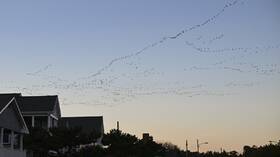A team of scientists from the US state of New Mexico has taken a new approach to studying the animal kingdom: by attempting to place drones on dead and mummified birds as part of an experiment to learn more about their flight patterns.
An assistant professor at the New Mexico Institute of Mining and Technology, Dr. “We had the idea that we could use dead birds and combine them into a drone. It’s all there. reverse engineering,” Mostafa Hassanalian told Reuters this week.
Hassanalian and his team came up with an unusual idea when they didn’t see the desired results when they released artificial mechanical “birds” into a flock of domestic animals. The drones contained in the stuffed birds are currently being tested in a special cage – but they can only fly for 20 minutes at a time now.
The project is expected to shed new light on the way birds conserve energy by flying in certain configurations when artificial drones are flown with live flocks. This data can be applied to simplify human flight.
“If we can learn how these birds manage energy among themselves, we can apply it to the aviation industry in the future for greater energy savings and greater fuel economy,” Hassanalian told Reuters. It is also hoped that the test will further clarify theories about how birds’ colors interact with flight efficiency.
Brenden Herkenhoff, another scientist, said: “We carried out experiments and determined that applying a certain color to our fixed-wing aircraft could change flight efficiency. We think the same is true for birds.”
Strangely, the nature of the study seems to fit the popular “birds aren’t real” conspiracy theory that for several years now has been claiming that birds are actually artificial drones flying in the sky to spy on people. The movement has followers in many countries of the world and has created a popular clothing style.
But Hassanalian emphasizes that his work has no ill intentions: “I honestly don’t know that ‘birds aren’t real’. I knew right away when my story first came out.”
Source: RT
Source: Arabic RT
